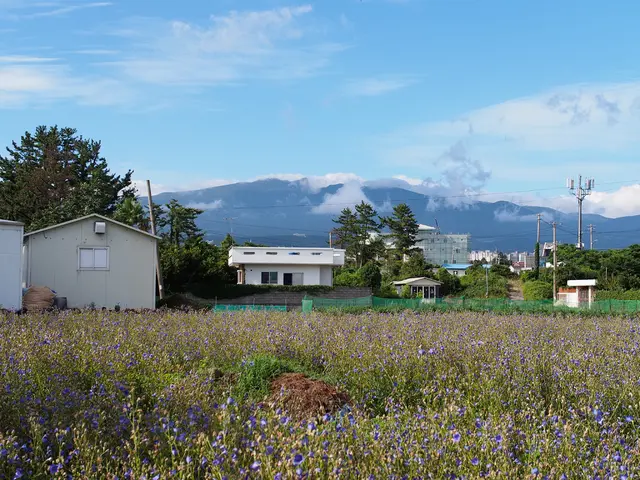Kazakhstan Pushes Forward with Green Energy Collaboration
Article:
🌎 Harnessing Green Energy Across Borders 🌍
The Caspian Sea, famed for its rich resources, is stepping into a new era of sustainability. Kazakhstan, Azerbaijan, and Uzbekistan are teaming up to create the Caspian Green Energy Corridor, a groundbreaking initiative with a vision to foster energy cooperation and promote renewable energyolutions.
The latest chapter in this eco-friendly mission unfolded at a ministerial meeting in Baku on April 4. Presided by Azerbaijan's President Ilham Aliyev, the meeting highlighted the corridor's prime focus: the Green Energy Corridor project. Representing Kazakhstan were Deputy Minister of Energy Sungat Yesimkhanov and KEGOC Chair Nabi Aitzhanov.
Kazakhstan is spearheading the push for eco-conscious solutions, championing technologies that harness associated gas and innovationstargeted at generating green hydrogen. As part of a historic trilateral agreement between the three nations, an ambitious venture is underway – the construction of a submarine high-voltage cable across the Caspian Sea.
Key role player KEGOC, the architect of Kazakhstan's power system, is right in the thick of the action. The state-owned entity is spearheading the construction of a deep-sea cable that will undulate beneath the Caspian Sea, becoming a cornerstone of the energy infrastructure. This submerged artery will bolster cooperation among Kazakhstan, Uzbekistan, and Azerbaijan.
During the meeting, intricate details regarding the feasibility study for the project were discussed, with plans to fund the research through donor grants.
The Caspian Green Energy Corridor is more than just a regional pact – it's a critical step towards establishing a cross-border green energy transmission network, empowering energy-rich Central Asian nations to export renewables. The initiative dovetails with broader efforts, such as the Central Asia-European Union green energy corridor, further emphasisizing its global importance.
And it's far from finished. The corridor's future hinges on a successful feasibility study and the all-important task of securing necessary funding to actualize the green energy dream. Buckle up for what's shaping up to be an exciting journey!
[Footnotes:]
[1] saany.ru
[2] adb.org
[3] kegoc.kz
[4] europa.eu
[5] indiaene.nic.in
[6] en.wikipedia.org
Enrichment Data:
The Caspian Green Energy Corridor initiative, involving Azerbaijan, Kazakhstan, and Uzbekistan, is progressing through a multilateral agreement. Key details include:
Current Status
- MOU Signing: On April 4, 2025, the Asian Development Bank (ADB), Asian Infrastructure Investment Bank (AIIB), and energy ministries of the three nations signed an agreement to conduct a feasibility study for the corridor.
- Objectives: The project aims to integrate energy systems and establish a cross-border green energy transmission network to facilitate renewable energy trade among Central Asian Regional Economic Cooperation (CAREC) member countries.
Key Components
- Regional Integration: Focuses on interconnecting grids and creating frameworks for cross-border electricity trade, leveraging renewable energy potential in the Caspian region.
- Submarine Cable Link: While specific details about a Caspian Sea submarine cable are not explicitly detailed in available reports, the project’s long-term vision includes transmitting green energy from the Caspian region to Europe via the Black Sea subsea cable, suggesting potential future submarine infrastructure.
- Institutional Framework: The MOU emphasizes developing legal and regulatory frameworks to enable regional cooperation and attract investment.
Strategic Importance
- Regional Cooperation: Addresses energy security and sustainability while promoting economic growth through renewable energy exports.
- Global Connectivity: Aligns with broader efforts, such as the Central Asia-European Union green energy corridor, which is also progressing with feasibility studies.
Distinct from India’s Green Energy Corridor
While sharing a similar name, India’s Green Energy Corridor (GEC) focuses on intra-state renewable integration:- Progress: Over 9,136 circuit km of transmission lines and 21,413 MVA substations completed under Phase I.- Expansion: Phase II extends to seven more states, with a third phase now under development. (Note: This is included to clarify potential confusion but is separate from the Caspian project.)
- The Caspian Green Energy Corridor's feasibility study will be funded through donor grants, as decided during the recent ministerial meeting in Baku.
- Kazakhstan's vision for the Caspian Green Energy Corridor involves championing technologies that generate green hydrogen and harness associated gas.
- KEGOC, a key role player in the Caspian Green Energy Corridor initiative, is leading the construction of a deep-sea cable to bolster cooperation among Kazakhstan, Uzbekistan, and Azerbaijan.
- The Caspian Green Energy Corridor is not only a regional pact but a critical step towards establishing a cross-border green energy transmission network, aligning with broader efforts such as the Central Asia-European Union green energy corridor.
- The successful implementation of the Caspian Green Energy Corridor relies on a successful feasibility study and securing necessary funding to actualize the green energy dream, a significant task that demands the combined effort of science, industry, finance, and environmental-science.







